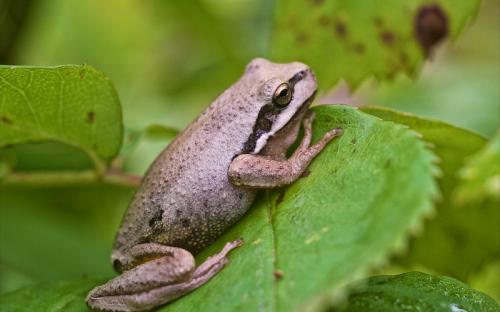Conservation status: least concern
What do they look like?
A small to medium sized frog that can grow up to 4.5cm. Despite being called ‘brown’, they can vary in colour quite a lot. They generally have a cream, brown or yellow-brown coloured back, with a white or pale yellow belly. They have a wide darker brown stripe down the middle length of their back. They often also have a dark stripe that runs from the tip of the nose to their upper arm. The belly is white. The pupil is horizontal and the iris is gold.
What to listen out for
Males can be heard making rapid ‘creeeeee cree cree cree’ sounds most of the year, although particularly between June to November, or when there has been a lot of rainfall.
LISTEN: https://www.youtube.com/watch?v=p_ClyeP1oBs
Where to find them
The Southern Brown Tree Frog lives in gardens, parks and nature reserves where there are bodies of water, low growing plants and lots of leaf litter. They are found throughout most of Victoria and Tasmania, as well as the southeast of New South Wales and South Australia.
You can spot them in Bayside at the Tulip Street Pond (near the Sandringham Leisure Centre), Pobblebonk Park (George St, Sandringham) and Yalukit Willam Nature Reserve (Elsternwick). You can listen for their calls any time of the year, but particularly late Winter to early Spring.
Life Cycle
These frogs can breed any time during the year when the conditions are right, although most commonly between the months of June and November. Females can lay up to 700 eggs in jellied clumps of 10 to 15 eggs at a time, in ponds, dams or streams, attached to vegetation or sticks under the surface to prevent currents carrying them away.
Tadpoles can reach up to 5.5cm in length after hatching, and take 6 to 7 months to mature into frogs. They may grow faster in warmer areas. They often remain at the surface of water and are very fast swimmers, darting away when disturbed.
Did you know?
• Being tree frogs, they are nimble climbers and jumpers, able to leap and snatch insects in mid-flight.
• During the night the Southern Brown Tree Frog will hunt for flying insects that are drawn to household lights, so look out for them attached to windows of your home on damp nights.
• Unlike most frogs, the Southern Brown Tree Frog is able to live away from permanent water sources. This is why they are commonly seen in suburban backyards.
Download our factsheet
FoNW Factsheet - Southern Brown Tree Frog
References and Further Reading
https://www.frogid.net.au/frogs/litoria-ewingii
https://backyardbuddies.org.au/backyard-buddies/southern-brown-tree-frog/
https://www.climatewatch.org.au/species/amphibians/southern-brown-tree-frog
Credits
Author: Nykita Ivanoff
Photo: The Blackthorn Orphans@Flickr

